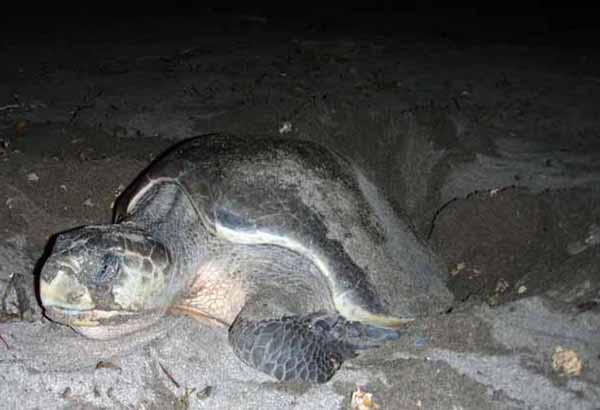Sexual Maturity
Estimates of sexual maturity in sea turtles vary not only among species, but also among different populations of the same species.
- Maturity may range from as early as 7 to 13 years for leatherbacks, 11 to 16 years for both species of ridleys, 20 to 25 years in hawksbills, 25 to 35 years for loggerheads and 26 to 40 years in green sea turtles.
- Because green sea turtles dine mostly on sea grasses and seaweed, they reach maturity at a much later age than other, more carnivorous sea turtles.
Sexual maturity often is related to carapace size.
- Studies have shown that hawksbills reach sexual maturity at a carapace size of 69 to 78 cm (27 to 31 in.).
- Loggerheads reach maturity at a carapace size of about 50 to 87 cm (20 to 34 in.).
- Leatherbacks reach maturity at 145 to 160 cm (57 to 63 in.).
Evidence suggests that some turtles continue to grow after reaching sexual maturity, while some stop growing after reaching maturity.

Mating Activity
For most species, courtship activity usually occurs several weeks before the nesting season.
Two or more males may court a single female.
Males have enlarged claws on their front flippers. These aid males in grasping the shells of the females during mating.

Fertilization is internal. Copulation takes place in the water, just offshore.

Nesting Behavior
Like other turtles, sea turtles lay eggs.
Females come ashore on a sandy beach to nest a few weeks after mating.
- Females usually nest during the warmest months of the year. The exception is the leatherback turtle, which nests in fall and winter.
- Females of most species usually come ashore at night, alone, most often during high tide.
- Because of their smaller size and lighter coloration, Kemp’s, olive ridleys, and flatbacks can nest during the day.
- A female sea turtle crawls above the high tide line and, using her front flippers, digs out a “body pit.” Then using her hind flippers, she digs an egg cavity. The depth of the cavity is determined by the length of the stretched hind flipper and can be up to 1 m (3.3 ft.) deep.
- A female deposits 50 to 200 (depending on the species) Ping Pong ball shaped-eggs into the egg cavity. The eggs are soft-shelled, and are papery to leathery in texture. They do not break when they fall into the egg cavity. The eggs are surrounded by a thick, clear mucus.
- Green sea turtles lay an average of 110 per clutch. The black subspecies lays fewer eggs — about 65 to 90 eggs per clutch.
- Like green turtles, olive and Kemp’s ridleys lay an average of 110 eggs per clutch.
- Hawksbill females lay an average of 130 eggs in a clutch.
- Loggerheads average about 122 eggs per clutch.
- Clutch size for flatbacks averages about 54 eggs.
- Leatherback nests typically contain 50 to 100 eggs.

- The female covers the nest with sand using her hind flippers. Burying the eggs serves three purposes: it helps protect the eggs from surface predators; it helps keep the soft, porous shells moist, thus protecting them from drying out; and it helps the eggs maintain proper temperature. Experts can identify the species of turtle by the type of mound left by the nesting female and by her flipper tracks in the sand.
- Females may spend two or more hours out of the water during the entire nesting process.
- It is possible that through the storage of sperm from one or several males in the oviducts of the females, all clutches of the current nesting season may be fertilized without repeated mating.
Female Kemp's ridley and olive ridley sea turtles form masses called arribadas (Spanish for "arrival"). Arribadas contain thousands of egg-bearing females that come ashore at the same time to lay eggs.
Most females return to the same beach where they hatched to nest each year.
- Recent studies suggest that some females of some species will visit more than one nesting beach (other than the original beach) in a season.
- Females usually lay between 1 and 9 clutches of eggs per season.
- Females may nest every 2 or 3 years.
- Female green turtles may lay 1,900 to 2,300 eggs within a lifetime.




